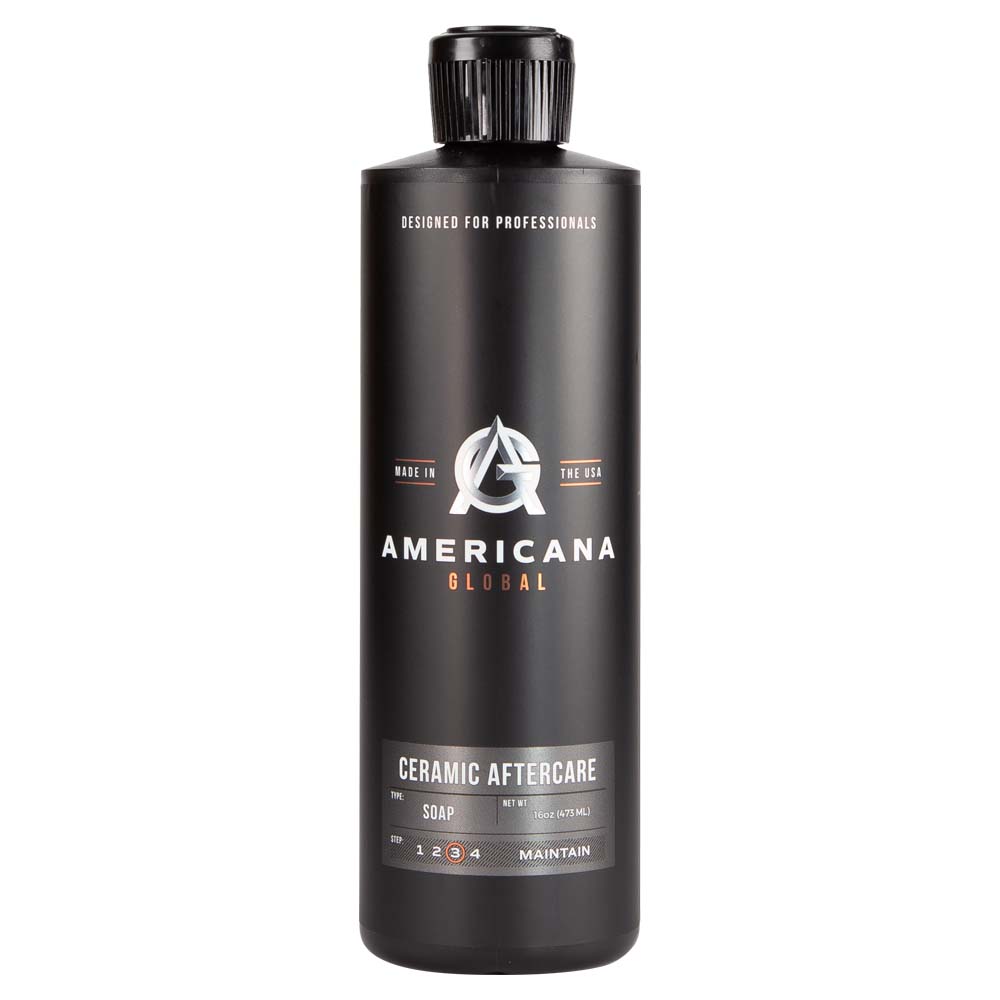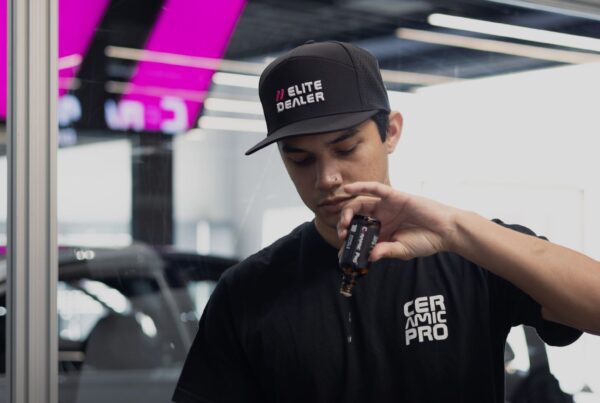What is Ceramic Coating?
In the global world of paint correction, ceramic coating reigns supreme. It’s the most diverse paint protection product in the world, but also the most misunderstood. And if we really want to be blunt – it’s also the consumer segment with the most knock-offs and misleading products that simply don’t build up to the hype.
By definition, a ceramic coating is an auto detailing product used to protect interior and exterior surfaces from common blemish causing materials. Primarily composed of silica and titanium dioxide, these two substances together form a covalent bond that is hydrophobic in nature and forms a nano-ceramic shield above the vehicle’s clear coat.
There are several grades of ceramic coatings on the market today. It’s also a statement of fact that a lot of myths and inaccurate information exists on the internet – such as comparing ceramic car coating with wax or a paint sealant. That’s not remotely relevant. So, let’s travel down the rabbit hole and provide an in-depth and honest review about ceramic coatings.
What Are the Different Types of Ceramic Coating?
There was a day when the ceramic coating world was simple. It was a professional-grade, high-quality silicon dioxide or SiO2 based formula, only available through authorized installers. The formulation was scientifically engineered to use nano-technology which would penetrate microscopic imperfections found in any solid surface that was porous in nature.
Today’s ceramic coating segment is a saturated one – with a blend of professional-grade options like Ceramic Pro to Teflon-based spray ceramic coatings on a car that replicate many attributes of real coatings but are sparse on protective qualities and longevity. There are even ceramic-infused car wax products that bond to the car’s paint and replicates some of the qualities.
Products like wax made from carnauba serve as a sacrificial layer on top of the painted surface. Paint sealants also help to protect a paint job. However, if you’re looking for the best liquid solution to protect the car’s surface, the ceramic coating reigns supreme.
Get a FREE Estimate for Ceramic Pro 9H Coatings Click ME to get your FREE Quote
Spray Coatings
This is the entry point in the ceramic coating for cars world. It’s basically a diluted solution that is easy to spray on a painted surface, wipe off, let cure, and see visible results. In this category, there are different grades and individual formulations including:
Teflon-Based Sprays – This is the quickest growing of the spray-coating products. It’s made from Teflon and Silicones that are “ceramic in nature” – but not the same ingredients you’ll find in Ceramic Pro for example. They are made to replicate attributes – like hydrophobic properties, a slippery look, and enhanced gloss. However, they are prone to swirl marks due to the soft ceramic materials in these products.
SiO2 Boost Sprays – These are closer to professional-grade coatings, but still quite diluted. They are comprised of about 15 to 20 percent of SiO2 and TiO2 or Titanium Dioxide. You’ll spray on the vehicle’s surface, buff off, and let it cure for about 24 to 48 hours. They provide similar features to the Teflon-based sprays, but with better UV protection qualities. While it’s better than carnauba wax, its not to be confused as a long-term solution.
Nano Ceramic Coatings
Nano-coatings are highly-concentrated formulas that used to provide superior protection on paint, glass, chrome, carbon fiber, and even vinyl or paint protection film.

This is where the term 9H ceramic coating comes into play. The 9H is the highest on the pencil scale of hardness. It’s basically as hard as a solid quartz crystal.
Like the spray coatings, there are two grades of nano coatings.
DIY Ceramic Coatings: The do-it-yourself nano coating is not a strong as the professional-grade coatings and is formulated to allow the average car enthusiast to apply. These products range from an SiO2 percentage of 50 percent to as high as the mid-80 percent with some.
The quality and results of these products are hard to predict, and usually contain no warranties. Even some DIY coatings with expected longevity guarantees are very vague in their language.
Ceramic Pro Coating: The Cadillac of ceramic coatings is the professional SiO2 Infused ceramic coating – like Ceramic Pro’s flagship product. These are precision formulated ceramic nanoparticles that are highly concentrated, with SiO2 percentages higher than 90%.
Our ceramic coating application is only offered by trained and certified installation experts, in a controlled environment to ensure optimal prep work, application, and longevity.
A professional ceramic coating product is backed by specific warranties – where passionate car owners can pick a package that fits their individual needs. It can be applied to car paint, uses as a glass coating, a protective coating on top of PPF or vinyl, and far exceeds traditional wax.
What is the Difference Between DIY Ceramic Coatings and Ceramic Pro?
Comparing a DIY nano coating to Ceramic Pro is like pairing up a Nissan Leaf vs a 2020 Dodge Hellcat Demon on the quarter mile drag strip. Sure, they’re both cars, but one is going to stomp the other.
Generally, the main difference between a professional grade or DIY ceramic coating is control of the multiple variables that impacts the end result, and the quality of the product for protecting the vehicle’s paint.
A nano-ceramic coating is a highly complex formulation, that has specific tolerances for prep work, adhesion, application, and removal. With a DIY coating, there is no control over these conditions – as such, results always vary. They both serve as a protective layer for the car’s paint, but are much different with regards to strength, durability and overall quality.
Then there is the 9H hardness factor. Most nano ceramic coatings will harden to this level on the pencil scale. However, a pro-grade ceramic coat like Ceramic Pro’s simply holds up for extended periods. It helps to block brake dust from sticking, acts as a stronger sealant, reduces minor scratches, and has superior wear resistance.
The Advantages of Professional Ceramic Coatings
When you take close look into professional grade options like Ceramic Pro products, there are several factors that should be factored into any decision made.
Advantages:
- It’s 100% Controlled: When you have a professional ceramic coating applied by a certified Ceramic Pro installation facility, the entire process is controlled for optimal results. From the customized prep work based on your specific vehicle, to the application, curing, and aftercare – you simply remove the variables that impact the longevity and durability of the coating.
- Stronger Formulation: The formulation of Ceramic Pro is simply stronger than any DIY coating. The higher percentage of SiO2 and other proprietary ingredients provides a much stronger bond to the surface where it’s applied. This means enhanced product qualities like hydrophobic properties, shine, and most important – protection against the elements.
- An Honest Warranty: Ceramic Pro is offered to our valued clients in package levels. Each package is specific based on the needs of those we serve. For example, if you’re looking for three years of protection for vehicle’s paint, because you’re going to trade in your car in a few years, we have a warranty for that. If you’re looking for lifetime protection on your family legacy car, we can hook you up there as well.
- Custom Formulations: One size does not fit all with a nano ceramic coating. While many DIY brands claim to “work” on multiple surfaces, their formulations do not produce equal results on different surface types. Ceramic Pro coatings are customized for specific materials and applications including glass, vinyl wraps, paint protection film, and for different applications – including industrial or marine applications.
Pros and Cons of DIY Ceramic Coating a Car
Let’s be clear, there are some DIY coatings that are good, and some that are legitimate snake oil. It’s difficult to lump them all in the same category, which is arguably the main problem with this type of coating. It’s truly a buyer beware industry filled with products with more hype than hope for a genuine ceramic paint coating on cars.
Pros of DIY Coatings:
- Cheaper than Professional Grade Products: The average cost of a DIY coating is about $70 per bottle. But you need to do your research to ensure you buy one that is right for your comfort level. Some kits come with supplies to install, while some are less than honest about what they offer.
- It’s a Good Do It Yourself Project: Applying a product like this is a great DIY project. If you’re looking to gain experience on how to polish a car, hand wash a vehicle correctly, and autobody care, this is a great way to learn by doing.
- Can Produce Very Good Results: To be honest, there are some coatings applied by experienced detailers that look great. But, it’s not really the coating – as much as the hard work and prep completed prior to the installation that makes the difference in appearance.
Cons of DIY Coatings:
- A Lot of Poor Results: The ceramic coat will flash or initially cure to the surface based on the temperature of surface, outside temperature, humidity, and the type of surface material. While lower SiO2 percentages expands the margin of error, the potential for errors based on these variables is extremely high.
- Inconsistent Application: Every DIY coating has specific instructions for “general use”. Some even offer a time and temperature recommendation for applying. However, when they say to use a few “drops” – that means something different for individual people. One person might apply 5 drops per application – while others will put 10. That impacts the thickness of the coating and thus the curing time.
- Premature Removal: Most DIYers look to finish projects as quickly as possible. This includes removing ceramic coatings for cars. It’s quite common for people to remove the coating too soon – which reduces the effectiveness and longevity of the coating.
- No Warranties: We’ve only seen (1) DIY coating that offers any warranty – and it’s capped at two years of “expected longevity”.
What Does a Nano-Ceramic Coating Do?
So – we’ve discussed the different type of ceramic coatings for cars, even showed the differences between different grades and application methods. But what exactly does a ceramic coating do for the automotive world?
Well, this is where a lot of the confusion and flat out misconceptions come into play. A ceramic coating is meant to PROTECT the finish or top layer of different materials found on a car, truck, SUV, motorcycle, or other piece of equipment.
It accomplishes this by forming a quartz-like transparent shell on the top coat that blocks UV light, chemicals, tree sap, brake dust, and other contaminants from the raw material underneath. The hydrophobic surface makes the car ultra slick, which allows water to just sheet off with little effort.
That’s the ultimate job of a ceramic coating. Now, where the confusion comes into play, is the level of this protection and the qualities or attributes that this type of coating produces.
Some of the qualities that result due to applying a ceramic coating for cars include:
- Improved Hydrophobic Properties: This is the ability to repel water, liquids, mud, dirt, and other light debris. You see a lot of cool videos of water beading or shedding off a freshly coated vehicle. That’s Hydrophobic.
- Protection for UV Light: Our sun is awesome for providing warmth and allowing life to thrive. It’s not so helpful on every part of your vehicle. UV rays penetrate clear coats on paint and lead to paint fading, stimulating oxidation, which ultimately results in corrosion and the development of rust. Ceramic coating paint blocks UV from causing this type of damage.
- Protection Against Chemicals and Animal Byproducts: Chemical agents such as salt and acids found in animal waste (like bird droppings and bug splatters) can also cause damage to car parts. The ceramic coating’s ultra-slick surface blocks these contaminants from penetrating to the root finish.
- Improved Luster and Shine: When ceramic coating cures, it’s basically a microscopic and strong layer of glass. This amplifies the shine and luster of paint, makes matte finishes on plastic trim appear deep and rich, and allows alloy and chrome wheels to pop.
- Simplifies Cleaning: Arguably the best feature of a ceramic coating is the non-stick properties, making it harder for dirt to stick and easier to remove. This acts as a self-cleaning property, as wind produced while driving simply blows away contaminants – keeping the vehicle cleaner for longer periods. You can also apply it to your wheels and brake calipers, which makes it easier for clean-up.
What Does a Ceramic Coating NOT Do?
Are you ready for some of the best myths involving ceramic coatings for cars? Cool – because honestly, there are a ton of misleading articles and marketing claims that negatively impacts the industry. Here are four of our favorite myths about ceramic coating for cars.
- Protects Your Ride from Fire: You’ll see a ton of videos promoting some ceramic coatings against a fire. They’ll pour some lighter fluid and light it, put out the fire in a few seconds, then simply wipe off the residue with a microfiber towel. Just to be clear – applying a ceramic coating spray or nano-ceramic coating will not make your vehicle fire-proof.
- Complete Scratch Proof Qualities: It’s also common to see some coatings wipe clean after being struck with a lighter. While most professional grade coatings can resist scratching – they are not 100% scratch proof. They can protect the surface, but the coating may likely scratch itself.
- Not Self-Healing: This is a quality that is produced by paint protection film, like Kavaca for example. When it’s scratched, nano-technology infused in a high-quality PPF will literally repair the scratch in a matter of seconds. But this isn’t possible with a solid ceramic coating.
- You Don’t Have to Wash Your Car with a Ceramic Coating: Yeah – this one just doesn’t make sense. While the coated car is slippery and it’s harder for dirt to stick, eventually it will. When it does, extra contaminants will stick to that dirt and debris. It’s recommended to wash any ceramic-coated car every two weeks with a PH-neutral soap. We recommend Americana Global Aftercare, the ultimate 2-in-1 automotive shampoo.
What’s the Verdict on Ceramic Coating?
A ceramic coating is a great way to protect your daily driver or valuable vehicle. However, it’s a product that is comprised of space age ingredients that are quite difficult to apply correctly.
While the rampant expansion of do-it-yourself coatings have given car owners more options, it’s important to understand the truth – that the ease of application always has a drawback.
If you’re thinking about investing in a ceramic coating for cars, for maximum protection, enhanced shine and luster, and longevity – do your research. Find one that fits your needs, budget, and provides you with the best return on your investment.







